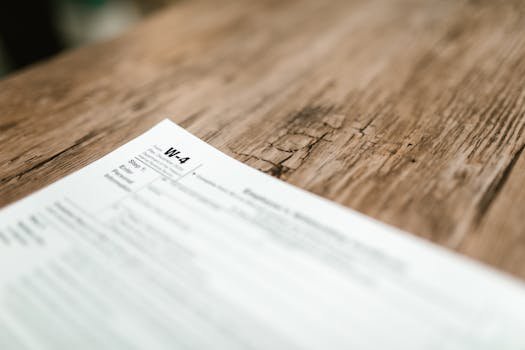This is the calm, practical guide to the W-8BEN for people who live out of a backpack. You’ll learn why the form exists, how to fill it out correctly, what to do when you switch countries, and how to avoid the 30% dividend haircut that hits anyone who forgets this step.
Introduction: What is the W-8BEN and why nomads need it
If you’re a non-US person buying US stocks (or US-listed ETFs/ADRs) while you travel, your broker will ask for Form W-8BEN. It’s not a tax return; it’s a status and treaty form. You give it to the withholding agent (your broker or the paying institution), not to the IRS, and they use it to (1) confirm you’re not a US person and (2) apply the right withholding rate on certain US-source income (notably dividends). Without it, the default rule bites: 30% withholding on dividends and some other passive income categories. With it, your treaty rate—often 15% or 0% for specific income types under some treaties—can apply. The W-8BEN is, in short, your way to say “I’m foreign, here’s where I’m tax resident, please withhold correctly.”
For nomads, the form raises two anxieties. First, fear of mistakes (“What if I check the wrong box and get in trouble?”). Second, residency churn (“I’m in Spain this quarter and Mexico next—what do I put?”). The good news: the W-8BEN is routine. Brokers process millions each year; their portals guide you, and you can update the form whenever your facts change. The validity is generous—usually until the last day of the third calendar year after you sign—unless a change in circumstances makes it inaccurate sooner (for example, you move countries and claim a different treaty). Bottom line: fill it once, review when you move, and you’ll keep dividends neat and predictable.
This guide walks line-by-line through the form, clarifies tax residence vs physical presence, explains when to renew, what your broker will do with it, and how your year-end Form 1042-S ties everything together. We’ll also cover common traps—missing TINs, wrong treaty articles, stale addresses—and show you how to fix them fast.
The 30% withholding problem explained
The US imposes a statutory 30% withholding on most US-source passive income paid to foreign persons (nonresident individuals and foreign entities). This is called NRA withholding. It’s designed as a collected-at-source mechanism so the US gets its share of tax without requiring every foreign recipient to file a US return. For investors, the headline item is dividends from US corporations. If you buy a US stock that pays $100 in dividends and your broker hasn’t documented your foreign status (and any treaty claim), the default is to withhold $30 and remit it to the IRS. You’ll see that deduction on your statements as withholding at 30%.
The key relief mechanism is a tax treaty between your country of residence and the US. If a treaty exists and you properly certify yourself on a W-8BEN (individual) or W-8BEN-E (entity), the withholding agent may apply a reduced rate (often 15% for portfolio dividends; exact rates vary). If no treaty applies—or your residency is in a jurisdiction whose treaty has been suspended or terminated—you’re back to 30%. Treaties are country-specific and can change over time (for instance, changes affecting Hungary and Russia have altered what some recipients can claim), so it’s smart to verify your country’s current status each time you move.
For nomads, the practical takeaway is simple: the W-8BEN is your dividend throttle. Fill it correctly, keep it current, and your broker’s system will usually apply the right rate automatically. Skip it—or let it go stale—and you’ll donate a chunk of your yield to the default rule. In the sections below, you’ll see exactly how to prevent that.
What happens without a W-8BEN
No W-8BEN on file means your broker cannot treat you as a foreign beneficial owner entitled to treaty benefits. Operationally, they must either (a) treat you as undocumented and withhold the statutory 30%, or (b) in some cases, restrict dividend-paying instruments until you submit documentation. The 30% default applies broadly to FDAP income (fixed, determinable, annual, or periodical)—dividends and certain interest categories—unless an Internal Revenue Code exception or treaty says otherwise. That withholding is at source; it reduces your cash receipt automatically, and the broker reports it to the IRS.
You’ll feel the pain in three places. First, your cash flow: every dividend is shaved. Second, your reinvestment plan (DRIP or manual buying) compounds more slowly. Third, your year-end: you’ll receive a Form 1042-S showing income paid and tax withheld. If you were eligible for a treaty rate but didn’t certify in time, some brokers allow documenting after the fact for future payments; retroactive corrections are limited and depend on rules and internal policies. If you think you were over-withheld and you’re eligible for treaty relief, the formal route is to file a US refund claim (e.g., Form 1040-NR)—but that’s a time-consuming path most nomads prefer to avoid by getting the W-8BEN right upfront.
Treaty rates vs default withholding
A treaty rate overrides the 30% default for qualifying residents of treaty countries, provided you claim it on your W-8BEN and furnish any required identifiers (like a foreign TIN). Typical portfolio-dividend rates in treaties are 15%; some treaties cut specific categories to 0%, and others have tiered rates based on ownership percentage or type of recipient. The broker can’t guess your eligibility; they need a valid W-8BEN with the treaty country identified and the correct article/paragraph selected (your broker’s wizard usually fills the articles for you based on your answers). If your residency changes to a non-treaty jurisdiction—or one where benefits have been suspended—your rate will revert to 30% after you update the form.
A practical nuance: since 2017, withholding agents typically require a foreign TIN or date of birth to grant treaty benefits on certain accounts—this helps them validate your residency claim. If you don’t have a foreign TIN for your stated treaty country, expect additional questions or a refusal to apply the treaty rate. Build a personal habit: when you establish tax residency somewhere, obtain your TIN, keep it in your encrypted docs, and include it on the form.
Who needs to file a W-8BEN?
If you are an individual who is not a US person and you receive US-source income through a withholding agent (broker, bank, or payer), you’ll almost certainly be asked for a W-8BEN. This includes EU/LatAm nomads who invest in US stocks/ETFs/ADRs, hold USD cash at US brokers that pay interest, or receive other US-source payments in a personal capacity. The form establishes your foreign status and, optionally, your treaty claim so withholding can be done right from day one. You provide it to the payer/agent, not to the IRS directly, and they rely on it (along with their KYC) to set your withholding profile.
If you never receive US-source payments (e.g., you only trade instruments that don’t produce US-source income, or your broker is non-US and blocks such payments), you might rarely see the form. In real life, most international brokers that route US dividends will request a W-8BEN during onboarding or before your first dividend hits. Treat it like standard paperwork—like setting up 2FA—rather than a special tax project. Submit it once, confirm it’s accepted, and diary the renewal date.
Non-US persons investing in US securities
“Non-US person” means not a US citizen, green-card holder, or resident under substantial presence for US tax purposes. If that’s you, and you own US securities that pay dividends (or certain interest), the payer must decide how much to withhold. With a valid W-8BEN on file, they will withhold at your treaty rate (if any). With no form, they must default to 30%. The broker also uses your form to code reporting on Form 1042-S at year end. This documentation isn’t optional window dressing; it’s part of the Chapter 3/Chapter 4 withholding framework that brokers are obligated to follow.
If you run a side business (e.g., content or services) and receive US-source service payments, the counterparty may also request W-8 forms—but that’s a separate fact pattern from investment income. Always give the correct version of W-8 for the exact relationship you have with the payer.
Difference between W-8BEN and W-8BEN-E
Easy rule: W-8BEN is for individuals; W-8BEN-E is for entities (companies, partnerships, trusts). The “-E” form asks extensive entity classification questions (FATCA status, chapter 4, GIIN where applicable) and has more moving parts. If you trade through a personal brokerage account, you’ll almost surely complete the individual form. If you invest via a foreign company or trust, you’ll be steered to W-8BEN-E and possibly additional documentation depending on structure and treaty article. Mis-using the forms (e.g., using W-8BEN for a company’s account) can lead to withholding at 30%, rejected documentation, and headaches down the line. When in doubt, match account owner type to the form.
How to fill out the W-8BEN: line-by-line guide
Every broker’s screen looks different, but the underlying fields mirror the IRS form. Here’s how to think about each part so you can breeze through confidently on mobile or desktop.
Part I: Identification of beneficial owner
Line 1 — Name: Your legal name exactly as on your passport. Avoid nicknames or app-style handles.
Line 2 — Country of citizenship: The country printed in your passport.
Line 3 — Permanent residence address: The address where you claim residency for tax purposes. This should not be a P.O. box or “care of” address. Use the jurisdiction for which you intend to claim treaty benefits (if any).
Line 4 — Mailing address (if different): Only enter if truly different; mismatches invite questions.
Line 5 — U.S. TIN: Most nomads don’t have one; leave blank unless you’ve been assigned an ITIN or SSN.
Line 6 — Foreign TIN: Enter the tax ID issued by your treaty country (NIF/NIE, NIN, CPF, CURP, etc.). If you don’t have a foreign TIN, your broker may still accept the form if date of birth is present, but many require the TIN to grant treaty rates.
Line 7 — Reference number(s): Optional; some brokers prefill an internal account ID.
Date of birth: Include it—this is a common completeness requirement now.
Nomad tips: Use the address of your tax residence, not the hotel where you’re staying. If you are in transition (closing one residence, opening another), wait until you can document the new residence (e.g., bank statement, municipal letter) so your W-8BEN aligns with your POA and your broker’s KYC.
Part II: Claim of tax treaty benefits
This is where you reduce withholding. You’ll check that you’re a resident of [Country] within the meaning of the treaty and, in many broker portals, the article/paragraph and rate will auto-populate. Make sure the country matches Line 3 and that you have the foreign TIN for that country. If your country has no treaty with the US, you can’t claim a reduced rate; leave the treaty claim unchecked and expect 30% withholding.
Some treaties require you to meet special limitation-on-benefits (LOB) tests or to certify beneficial ownership carefully (you, not someone else, are entitled to the income). If the portal asks additional residency questions (e.g., Are you subject to tax in [Country]?), answer truthfully. If you recently moved and don’t yet have a tax ID or credible proof that you’re resident under that country’s law, don’t claim the treaty yet—stick to 30%, then update later when your facts are solid.
Part III: Certification
You sign to certify (1) you’re the beneficial owner, (2) you’re not a US person, (3) the income is either not effectively connected or, if it is, you’ll handle it differently, and (4) your treaty statements are correct. You also affirm that if facts change, you’ll notify the withholding agent within 30 days and submit a new form. Electronic signatures via broker portal are accepted; the broker retains the form and relies on it until expiry or change in circumstances. Read before you click, then submit. Servicio de Impuestos Internos
Pro move: Screenshot the confirmation page and save a PDF copy of the generated form (many brokers let you download it). File it in your “Tax/Docs/W-8” folder with the date so you can track renewals.
The nomad’s dilemma: which country of residence to claim?
This is the #1 worry for drifters: “I’m in Spain this quarter, Portugal next, then Mexico—what do I put for residency?” The treaty system is based on tax residence, not your GPS dot. The country you list in Line 3 (and claim in Part II) should be the country where you are resident under local tax law, typically evidenced by a TIN, registration, or clear presence tests (days + home). If you are in between residences, it’s safer to delay making a treaty claim until you can credibly assert one—your broker can still treat you as foreign (avoid 30%? No; without treaty you’ll be at 30%) and you can update once your new residency is settled.
Consider the downstream evidence: if your broker’s KYC has a proof of address from Country A and your W-8BEN claims a treaty with Country B, expect follow-up. You’ll either need to align the two (update your KYC address and provide a POA from Country B) or explain the discrepancy. When in doubt, keep things consistent: W-8BEN country, POA, and the TIN should all point to the same jurisdiction.
Tax residence vs physical presence
Tax residence is a legal status under a country’s internal law (and sometimes modified by treaty tie-breaker rules). Physical presence—your day count in a place—often informs tax residence but isn’t identical. For example, spending 90 days in Spain doesn’t automatically make you tax resident there; conversely, registering for a NIE/NIF and meeting Spain’s 183-day rule can. For treaties, what matters is your status as a resident of [Country] under the treaty’s definitions. If you meet that, you can claim the treaty. If you don’t, you shouldn’t. Your broker’s portal usually asks only basic questions; the burden is on you to be truthful.
Nomad heuristic: Where do you (1) pay or file income tax, (2) have a TIN, (3) hold your primary address? That’s your default treaty country. If you’re between homes, accept the 30% for a few months and update once your new status is official.
When you’re between countries
Moving from Portugal to Mexico in June, with no definitive tax residence for the current year yet? Don’t guess. Use the country where you can document residency today. If that’s unclear, complete W-8BEN without treaty claim (foreign status only) so at least your broker doesn’t treat you as a US person. You’ll take 30% on dividends meanwhile; once you secure a Mexican RFC (or other TIN) and POA, update the form to Mexico and claim the treaty (if applicable). Some brokers re-apply rates seamlessly on the next payment cycle.
If you truly need relief sooner, speak to your broker: some allow re-documentation mid-year with immediate effect, provided your file (KYC + W-8) is consistent. Keep your TIN letters, registration screenshot, and POA PDFs handy in an encrypted cloud folder so you can respond quickly.
Using tax residence certificates
A tax residence certificate (TRC) from your country can be powerful evidence if your treaty claim is questioned. Not all brokers ask for it, but having a recent TRC (this calendar year) can speed up reviews or appeals. The process to obtain a TRC varies—many countries issue it online to registered taxpayers. If you’re a consistent nomad who spends full years in multiple places, consider maintaining a primary residence where you can reliably obtain a TRC; it simplifies your treaty life. Keep in mind: a TRC supports your treaty claim, but the W-8BEN itself is still required.
When and how to update your W-8BEN
Treat the W-8BEN like a passport stamp with a renewal cycle. Most brokers email you long before it expires. Your job is to submit an updated form whenever needed and to trigger one early if your facts change.
3-year validity period
As a general rule, a W-8BEN remains valid from the date you sign until the last day of the third succeeding calendar year. For example, sign June 10, 2025 → valid through December 31, 2028. Certain accounts and purposes may treat a form as indefinitely valid unless your circumstances change, but many brokers operationalize the 3-calendar-year standard to keep files fresh. Don’t overthink it—calendar a reminder one month before the December expiry and refresh it online.
Triggering events that require updates
You must update within 30 days if any information becomes incorrect. Common triggers:
- You move countries and your treaty residence changes.
- Your name changes (marriage/legal).
- Your status changes—you become a US person (e.g., green card).
- Your foreign TIN changes or is issued after you filed without one.
- Your mailing/permanent address no longer reflects your treaty claim.
Brokers often detect changes via KYC (address updates) and will prompt you to resubmit. Beat them to it; updates are quick online and prevent mis-withholding on the next dividend.
Address changes while traveling
If you’re merely swapping mailing addresses inside the same treaty country, update your broker’s profile and leave the treaty claim as-is. If your permanent residence (Line 3) moves to a new country, you have a change in circumstances—submit a new W-8BEN with the new country and TIN. Align your POA and KYC so the files tell a consistent story. If you can’t yet prove new residence, consider holding off on claiming the treaty until you can; the broker may temporarily apply 30%.
Understanding your broker’s W-8BEN process
Operationally, the broker is the withholding agent. They request the W-8BEN, validate it against your KYC, and store it electronically. When a US dividend is paid, their system looks at (1) your status (foreign vs US), (2) any treaty rate, and (3) the income code, then withholds and reports accordingly. Most brokers route the data into year-end 1042-S files for you and 1042/1042-S reporting for the IRS. If your W-8BEN is missing or expired, their system falls back to 30% by default.
Practically: expect to complete the form during onboarding or before the first dividend. Portals have improved: they ask plain-English questions and generate the proper articles/paragraphs automatically. If you change country, redo the form immediately in the portal—don’t wait for the next dividend. Keep your foreign TIN handy; many brokers will not apply treaty rates without it (or at least your date of birth, depending on account type and where it’s booked).
Form 1042-S: Your year-end withholding statement
Each year, your broker issues Form 1042-S showing the US-source income you received as a foreign person and the tax withheld under chapter 3 or 4. Think of it as the nonresident equivalent of a 1099 for payments subject to NRA withholding. You’ll typically get one or more 1042-S forms around February–March (timing varies), with income codes, gross amounts, tax rates, and withholding amounts. Keep them for your records—and to reconcile your dividend cash flows.
If you believe you were over-withheld (e.g., you qualified for a treaty but didn’t claim it in time), ask your broker whether they can correct past payments. If not, the pathway is a refund claim via Form 1040-NR, which is paperwork heavy and slow—another reason to keep your W-8BEN current. With tidy documentation, your 1042-S numbers should match what you saw in statements, making life easier for any home-country tax reporting you must do.
Common W-8BEN mistakes to avoid
Using the wrong form. Individuals should not file W-8BEN-E; entities should not use W-8BEN. Wrong form = document rejection or 30% fallback.
Mismatched country and address. Claiming treaty benefits with Country A while your permanent address and KYC show Country B is a red flag. Align your POA, TIN, and treaty country.
No foreign TIN. Many brokers won’t grant treaty rates without a foreign TIN (or at minimum DOB). If you lack a TIN, get one as soon as you establish residency; until then, expect 30%.
Letting the form expire. Calendar your renewal—forms generally expire on the last day of the third calendar year after signing (unless certain indefinite rules apply). An expired form reverts you to 30%.
Not updating after a move. Changing tax residence without updating W-8BEN is a classic mistake. Submit a new form within 30 days of the change.
Confusing W-8BEN with a US tax return. The W-8BEN goes to the withholding agent, not the IRS; it’s about status and withholding, not filing a return. If you need a refund, that’s a separate process (e.g., 1040-NR).
Assuming all treaties are static. Treaty availability and rates can change; some treaty relationships have been suspended or altered. Verify your country’s current position before making a claim.
Set it and (mostly) forget it
Think of W-8BEN as your dividend passport. Fill it once, keep it honest, renew on schedule, and update it when your tax residence changes. The prize is simple: clean dividends—with the right withholding—while you roam from coworking spaces to mountain buses. Save copies of your submissions, keep your foreign TIN and POA ready in a secure folder, and glance at your 1042-S each year to confirm the math. Do that, and the W-8BEN fades into the background where it belongs—just another checkbox on your nomad systems list, not a source of anxiety or lost yield.



